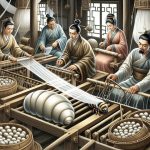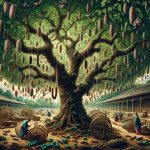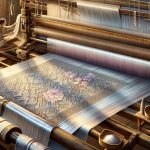Discover the fascinating history of silk as you delve into the origins and secrets of this luxurious fabric. Unravel the threads of soft gold as you explore the ancient origins, sericulture techniques, and the global trade network of the Silk Road.
From art to fashion, silk has left its mark on history. Join us on this journey to uncover the stories behind this remarkable textile. Get ready to be captivated by the allure of silk’s past.
Table of Contents
Ancient Origins and Discovery
You will learn about the ancient origins and discovery of soft gold.
Soft gold, also known as electrum, is a natural alloy of gold and silver that has been used by civilizations since ancient times.
The origins of soft gold can be traced back to the ancient techniques employed by early civilizations. Archaeological evidence suggests that the first discovery of soft gold occurred in the ancient city of Sardis in present-day Turkey. The city was renowned for its rich deposits of gold and silver, which were commonly found in the nearby river. The ancient inhabitants of Sardis developed sophisticated methods to extract and refine these precious metals, leading to the discovery of soft gold.
This discovery revolutionized the way these civilizations approached metallurgy and craftsmanship. The use of soft gold spread rapidly across various ancient civilizations, including the Egyptians, Greeks, and Persians. It became highly valued for its unique properties, such as its malleability and resistance to tarnish.
The ancient origins and discovery of soft gold laid the foundation for its widespread use throughout history, making it an integral part of ancient cultures and civilizations.
Silk Production and Sericulture
Silk production and sericulture have played a significant role in ancient civilizations, shaping economies and cultural exchanges. The art of silk farming techniques has been passed down through generations, contributing to the world’s fascination with this luxurious fabric. Silk production has flourished in various countries, each with their own unique methods and traditions.
| Country | Silk Production Techniques |
|---|---|
| China | The birthplace of silk, China is known for its traditional sericulture methods, involving the cultivation of mulberry trees and the careful rearing of silkworms. |
| India | India has a long history of silk production, with silk farming techniques varying across different regions. The state of Karnataka is renowned for its mulberry silk, while Assam is known for its golden muga silk. |
| Japan | Japanese sericulture emphasizes the use of organic methods, such as feeding silkworms with pesticide-free mulberry leaves. The country’s silk production is highly regarded for its quality and attention to detail. |
| Italy | Italy is famous for its silk weaving and textile industry. The region of Como is particularly renowned for its silk production, with skilled artisans using traditional techniques to create exquisite fabrics. |
Silk production and sericulture continue to thrive in these countries, keeping alive the ancient traditions and craftsmanship that have shaped the global silk industry. From the careful cultivation of mulberry trees to the delicate process of silk reeling, each step in the production of this soft gold contributes to the rich tapestry of human history.
The Silk Road: A Global Trade Network
The Silk Road wove together an intricate global trade network, connecting civilizations and facilitating the exchange of goods, ideas, and cultures. This ancient trade route, spanning over 4,000 miles, had a profound impact on the economies and societies along its path.
-
Cultural exchange: The Silk Road served as a conduit for the exchange of diverse cultures. Merchants, travelers, and scholars from different civilizations interacted, leading to the sharing of customs, languages, religions, and artistic styles. This cultural exchange enriched the civilizations along the Silk Road and fostered a sense of global interconnectedness.
-
Impact on economy: The Silk Road played a crucial role in boosting the economies of the regions it connected. The trade of silk, spices, precious metals, and other luxurious goods brought immense wealth to merchants and facilitated economic growth. Additionally, the Silk Road stimulated the development of industries and infrastructures such as caravanserais and trade cities, creating job opportunities and fostering economic prosperity.
-
Transmission of knowledge: Along with goods, the Silk Road was a vehicle for the exchange of knowledge and ideas. Scholars, philosophers, and scientists traveled the Silk Road, sharing their knowledge and discoveries with different cultures. This intellectual exchange led to advancements in fields such as astronomy, medicine, and mathematics, contributing to the overall progress of human civilization.
The Silk Road truly served as a bridge between civilizations, fostering cultural exchange and transforming economies. Its legacy continues to inspire and remind us of the power of global trade and human connections.
Silk in Art and Fashion
Artists and designers have long embraced the luxurious and versatile material of silk in their creations. Throughout ancient civilizations, silk was highly valued and played a significant role in art and fashion. Its shimmering texture and vibrant colors made it a favorite among artists, who used it to create intricate tapestries, paintings, and sculptures.
In religious art, silk symbolism was prevalent. Silk was often used to depict divinity, purity, and spirituality. It was woven into beautiful garments worn by priests and priestesses, symbolizing their connection to the divine. The smoothness and elegance of silk added a sense of reverence to religious ceremonies and rituals.
In the world of fashion, silk continues to be a coveted fabric. Its lustrous appearance and soft feel make it ideal for creating luxurious clothing and accessories. Designers incorporate silk into their collections, showcasing its versatility in flowing dresses, tailored suits, and delicate scarves. The natural drape of silk enhances the movement of the garments, adding an element of grace and sophistication.
Silk remains a symbol of opulence and refinement, carrying with it the rich history of ancient civilizations and religious traditions. From art to fashion, silk continues to captivate and inspire, standing as a testament to its enduring allure.
Modern Silk Industry and Sustainability Efforts
As you delve into the modern silk industry and its sustainability efforts, you’ll find a growing focus on environmentally-friendly practices and ethical production methods. The industry has recognized the need to reduce its impact on the environment and adopt more responsible approaches to silk production.
Here are three key initiatives that are gaining momentum:
-
Silk Recycling: To minimize waste and promote a circular economy, silk recycling programs have been introduced. Through these programs, silk waste is collected and transformed into new products, reducing the need for raw silk production and conserving natural resources.
-
Ethical Practices: Many silk producers are now prioritizing ethical practices throughout the entire supply chain. This includes ensuring fair wages and safe working conditions for silk farmers and workers, as well as implementing measures to protect the welfare of the silkworms. Transparency and traceability are also becoming increasingly important, allowing consumers to make informed choices about the silk products they purchase.
-
Sustainable Farming: Silk farmers are embracing sustainable farming methods to minimize their environmental footprint. This includes reducing pesticide and chemical use, implementing water conservation practices, and adopting organic farming techniques. By prioritizing sustainability, the modern silk industry is striving to preserve the delicate balance between silk production and the natural environment.
Through silk recycling, ethical practices, and sustainable farming, the modern silk industry is making significant strides towards a more sustainable future. As consumers, we also have a role to play by supporting brands that prioritize these initiatives and opting for silk products that are produced with care for both people and the planet.
Frequently Asked Questions
What Are the Different Types of Silk Fibers and How Are They Produced?
Silk production techniques vary depending on the type of silk fiber. Bombyx mori silk is produced by silkworms, while wild silk is obtained from various species. Properties like strength and luster differ among the fibers.
How Did the Production of Silk Spread From China to Other Parts of the World?
The production of silk spread from China to other parts of the world through the Silk Road. Merchants, explorers, and travelers carried silk along the ancient trade routes, introducing it to new cultures and regions.
What Are Some Famous Historical Figures or Events Associated With the Silk Road?
Marco Polo and the Great Silk Road are famous historical figures and events associated with the Silk Road. They played a crucial role in the spread of silk and trade between different parts of the world.
How Has the Use of Silk in Art and Fashion Evolved Over Time?
Over time, silk has evolved in art and fashion, reflecting changes in cultural significance and influence. Its use has transformed, adapting to new styles and techniques. Explore the fascinating journey of silk’s evolution.
What Are Some Current Sustainability Initiatives and Practices in the Modern Silk Industry?
In the modern silk industry, there are various sustainability initiatives and practices. Sustainable manufacturing methods are employed to minimize environmental impact, while ethical sourcing ensures fair treatment of workers and preservation of biodiversity.
- How Does Ring Spun Cotton Affect Garment Fit and Shape Retention? - August 13, 2024
- What Are the Challenges in Producing Ring Spun Cotton? - August 13, 2024
- Is Ring Spun Cotton Suitable for Plus-Size Clothing? - August 13, 2024






